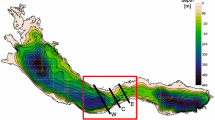Abstract
Significant insight into the dynamic local site response of a horizontally layered sediment deposit to seismic excitation can be gained from numerical simulations. In this paper we use a nonlinear local site response analysis code SPECTRA to estimate the coseismic sediment deformation at a seismically active site in Lotung, Taiwan. We address some basic issues relevant for interpreting the simulation results, including the impact of noise and baseline offsets present in the input ground motion. We also consider the sensitivity of the predicted deformation responses to statistical variations of sediment constitutive properties. Finally, we apply a suite of hypothetical strong ground motions to the base of the sediment deposit to better understand the pattern of inelastic deformation likely to result from strong seismic shaking.
























Similar content being viewed by others

References
Ambraseys NN, Menu JM (1998) Earthquake induced ground displacements. Earthq Eng Struct Dyn 16:985–1006
Anderson DG, Tang YK (1989) Summary of soil characterization program for the Lotung large-scale seismic experiment. In: Proceedings of EPRI/NRC/TPC workshop on seismic soil–structure interaction analysis techniques using data from Lotung, vol 1, Taiwan, EPRI NP-6154, Electric Power Research Institute, Palo Alto, CA, pp 4.1–4.20
Andrade JE, Borja RI (2006) Quantifying sensitivity of local site response models to statistical variations in soil properties. Acta Geotech 1:3–14
Borja RI, Amies AP (1994) Multiaxial cyclic plasticity model for clays. J Geotech Eng 120:1051–1070
Borja RI, Chao HY, Montáns FJ, Lin CH (1999) Nonlinear ground response at Lotung LSST site. J Geotech Eng 125:187–197
Borja RI, Chao HY, Montáns FJ, Lin CH (1999) SSI effects on ground motion at Lotung LSST site. J Geotech Eng 125:760–770
Borja RI, Lin CH, Sama KM, Masada GM (2000) Modeling non-linear ground response of non-liquefiable soils. Earthq Eng Struct Dyn 29:63–83
Borja RI, Duvernay BG, Lin CH (2002) Ground response in Lotung: total stress analyses and parametric studies. J Geotechn Geoenviron Eng 128:54–63
Boore DM, Bommer JJ (2005) Processing of strong-motion accelerograms: needs, options and consequences. Soil Dyn Earthq Eng 25:93–115
Boore DM, Stephens CD, Joyner WB (2002) Comments on baseline correction of digital strong-motion data: examples from the 1999 Hector Mine, California, earthquake. Bull Seismol Soc Am 92:1543–1560
Bradner H, Reichle M (1973) Some methods for determining acceleration and tilt by use of pendulums and accelerometers. Bull Seismol Soc Am 63:1–7
Elgamal AW, Zeghal M, Tang HT, Stepp JC (1995) Lotung downhole array. I: Evaluation of site dynamic properties. J Geotech Eng 121:350–362
Electric Power Research Institute (1993) Guidelines for determining design basis ground motions, vol 1. Method and guidelines for estimating earthquake ground motion in North America. Technical report no. TR-102293, Electric Power Research Institute, Palo Alto, CA
Hardin BO, Drnevich VP (1972). Shear modulus and damping in soils: design equations and curves. J Soil Mech Found Div ASCE 98:667–692
Hashash YMA, Park D (2002) Viscous damping formulation and high frequency motion in non-linear site response analysis. Soil Dyn Earthq Eng 22:611–624
Hilber HM, Hughes TJR, Taylor RL (1977) Improved numerical dissipation for time-integration algorithms in structural dynamics. Earthq Eng Struct Dyn 5:283–292
Idriss IM, Sun JI (1992) Users manual for SHAKE91. Center for Geotechnical Modeling, University of California, Davis
Kramer SL (1996) Geotechnical earthquake engineering. Prentice-Hall, NJ
Lee MKW, Finn WDL (1991) DESRA-2C: dynamic effective stress response analysis of soil deposits with energy transmitting boundary including assessment of liquefaction potential. The University of British Columbia, Faculty of Applied Science, Vancouver, BC
Li XS, Wang ZL, Shen CK (1992) SUMDES: a nonlinear procedure for response analysis of horizontally-layered sites subjected to multi-directional earthquake loading. Department of Civil Engineering, University of California, Davis
Newmark N (1965) Effects of earthquakes on dams and embankments. Géotechnique 15:139–159
Pyke RM (1992) TESS: a computer program for nonlinear ground response analyses. TAGA Engineering Systems and Software, Lafayette
Rodriguez-Marek A, Bray JD (2006) Seismic site response for near-fault forward directivity ground motions. J Geotech Geoenviron Eng 132:1611–1620
Schnabel PB, Lysmer J, Seed HB (1972) SHAKE—a computer program for earthquake response analyses of horizontally layered sites. Report no. EERC 72-12, University of California, Berkeley
Shakal AF, Petersen PD (2001) Acceleration offsets in some FBA’s during earthquake shaking (abstract). Seism Res Lett 72:233
Tang HT (1987) Large-scale soil-structure interaction. EPRI NP-5513-SR Special Report, Electric Power Research Institute, Palo Alto, CA
Trifunac MD, Todorovska MI (2001) A note on the useable dynamic range of accelerographs recording translation. Soil Dyn Earthq Eng 21:275–286
Zeghal M, Elgamal AW, Tang HT, Stepp JC (1995) Lotung downhole array. II: Evaluation of soil nonlinear properties. J Geotech Eng 121:363–378
Acknowledgments
We thank Dr. H.T. Tang and Electric Power Research Institute for providing the digitized ground motion data for the Lotung earthquakes. We also thank Dr. H. Haddadi for providing raw ground motion data for Gilroy 1, and Dr. C. Menun for allowing us to use the program CARDINAL. This research was funded by NSF Grant No. CMS-0201317.
Author information
Authors and Affiliations
Corresponding author
Rights and permissions
About this article
Cite this article
Borja, R.I., Sun, W.C. Estimating inelastic sediment deformation from local site response simulations. Acta Geotech. 2, 183–195 (2007). https://doi.org/10.1007/s11440-007-0044-x
Received:
Accepted:
Published:
Issue Date:
DOI: https://doi.org/10.1007/s11440-007-0044-x



